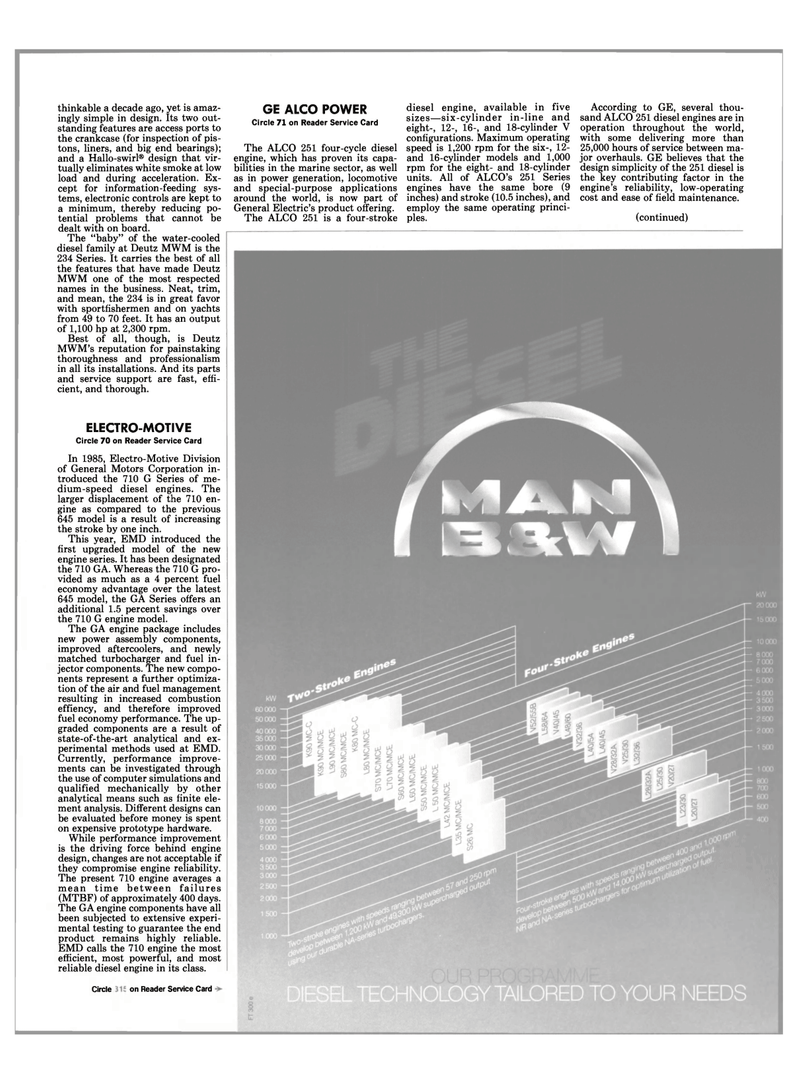
Page 22: of Maritime Reporter Magazine (July 1990)
Read this page in Pdf, Flash or Html5 edition of July 1990 Maritime Reporter Magazine
thinkable a decade ago, yet is amaz- ingly simple in design. Its two out- standing features are access ports to the crankcase (for inspection of pis- tons, liners, and big end bearings); and a Hallo-swirl® design that vir- tually eliminates white smoke at low load and during acceleration. Ex- cept for information-feeding sys- tems, electronic controls are kept to a minimum, thereby reducing po- tential problems that cannot be dealt with on board.
The "baby" of the water-cooled diesel family at Deutz MWM is the 234 Series. It carries the best of all the features that have made Deutz
MWM one of the most respected names in the business. Neat, trim, and mean, the 234 is in great favor with sportfishermen and on yachts from 49 to 70 feet. It has an output of 1,100 hp at 2,300 rpm.
Best of all, though, is Deutz
MWM's reputation for painstaking thoroughness and professionalism in all its installations. And its parts and service support are fast, effi- cient, and thorough.
ELECTRO-MOTIVE
Circle 70 on Reader Service Card
In 1985, Electro-Motive Division of General Motors Corporation in- troduced the 710 G Series of me- dium-speed diesel engines. The larger displacement of the 710 en- gine as compared to the previous 645 model is a result of increasing the stroke by one inch.
This year, EMD introduced the first upgraded model of the new engine series. It has been designated the 710 GA. Whereas the 710 G pro- vided as much as a 4 percent fuel economy advantage over the latest 645 model, the GA Series offers an additional 1.5 percent savings over the 710 G engine model.
The GA engine package includes new power assembly components, improved aftercoolers, and newly matched turbocharger and fuel in- jector components. The new compo- nents represent a further optimiza- tion of the air and fuel management resulting in increased combustion effiency, and therefore improved fuel economy performance. The up- graded components are a result of state-of-the-art analytical and ex- perimental methods used at EMD.
Currently, performance improve- ments can be investigated through the use of computer simulations and qualified mechanically by other analytical means such as finite ele- ment analysis. Different designs can be evaluated before money is spent on expensive prototype hardware.
While performance improvement is the driving force behind engine design, changes are not acceptable if they compromise engine reliability.
The present 710 engine averages a mean time between failures (MTBF) of approximately 400 days.
The GA engine components have all been subjected to extensive experi- mental testing to guarantee the end product remains highly reliable.
EMD calls the 710 engine the most efficient, most powerful, and most reliable diesel engine in its class.
Circle 224 on Reader Service Card
GE ALCO POWER
Circle 71 on Reader Service Card
The ALCO 251 four-cycle diesel engine, which has proven its capa- bilities in the marine sector, as well as in power generation, locomotive and special-purpose applications around the world, is now part of
General Electric's product offering.
The ALCO 251 is a four-stroke diesel engine, available in five sizes—six-cylinder in-line and eight-, 12-, 16-, and 18-cylinder V configurations. Maximum operating speed is 1,200 rpm for the six-, 12- and 16-cylinder models and 1,000 rpm for the eight- and 18-cylinder units. All of ALCO's 251 Series engines have the same bore (9 inches) and stroke (10.5 inches), and employ the same operating princi- ples.
According to GE, several thou- sand ALCO 251 diesel engines are in operation throughout the world, with some delivering more than 25,000 hours of service between ma- jor overhauls. GE believes that the design simplicity of the 251 diesel is the key contributing factor in the engine's reliability, low-operating cost and ease of field maintenance. (continued)

 21
21

 23
23
